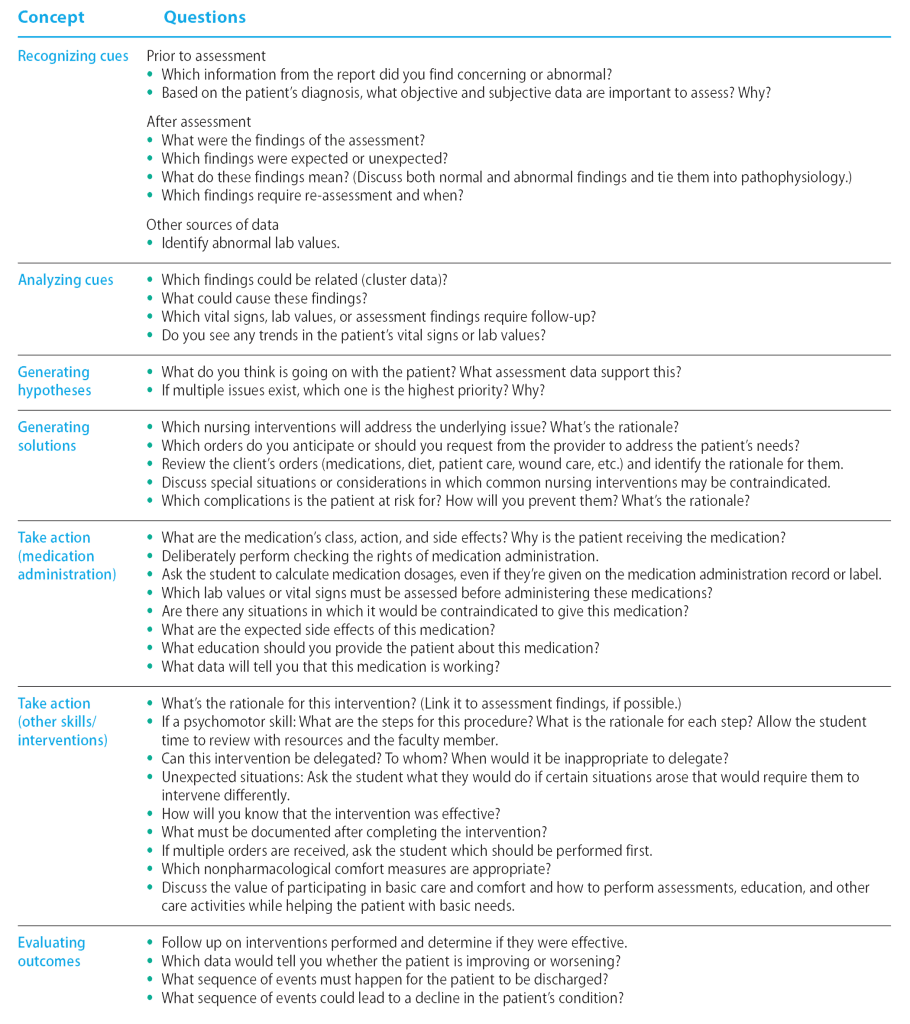Approaches that meet student and nurse needs.
- Direct care nurses serve as significant teachers and role models for nursing students in the clinical setting.
- Building critical thinking skills is one of the most important outcomes in the clinical setting for nursing students.
- Collaboration with nursing faculty during the clinical rotation can ease the burden on direct care nurses and facilitate a positive learning experience for the student.
The nursing profession continues to experience several challenges—some longstanding and exacerbated by the COVID-19 pandemic. The shortage of nurses at the bedside and reports of nurses planning to leave the profession soon place stress on the workforce and the healthcare system. The situation has put even more pressure on nursing schools to recruit and retain students who enter the workforce well-prepared for practice and capable of filling these vacancies. However, concerns exist surrounding students’ critical thinking skills and their readiness for a demanding career.
The challenge
A longstanding shortage of nursing school faculty and a reliance on new graduate nurses to serve as preceptors create challenges to properly preparing nursing students for a demanding role that requires excellent critical thinking skills.
What-Why-How? Improving Clinical Judgement
New nurses and clinical judgment
Nurse faculty shortage
Lack of interest and incentives lead to difficulty recruiting nurses from the bedside or practice to education. Many 4-year schools require a terminal degree to teach full-time in their undergraduate programs, but only 1% of nurses hold a PhD. In addition, according to the National Advisory Council on Nurse Education and Practice (NACNEP), the average doctorally prepared nurse faculty member is in their 50s, which means they may soon retire. The surge in doctor of nursing practice programs has helped to bridge this gap, but attracting advanced practice nurses to academia from their more lucrative practice roles continues to prove difficult.
Concerns about the practice readiness of new graduate nurses have existed for several years. Missed clinical experiences and virtual learning during the COVID-19 pandemic heightened those concerns. The National Council of State Boards of Nursing (NCSBN) addressed the calls from nurse employers to make progress in this area by revamping the NCLEX-RN and NCLEX-PN exams to create Next Generation NCLEX (NGN), which includes more clinical judgment and critical thinking items. Nurse educators are working hard to prepare students for both practice and the new exam items by incorporating more active learning into classroom, clinical, and lab activities and emphasizing the importance of clinical judgment skills.
In most areas of the country, clinical student experiences have returned to pre-pandemic arrangements. State boards of nursing mandate maximum faculty-to-student ratios for clinical experiences. Schools can choose to have faculty supervise fewer students than the maximum, but faculty and clinical site shortages may eliminate that option. In many cases, preceptor-style experiences (such as capstone or practicum courses) have higher faculty-to-student ratios, and preceptors may have to meet specific criteria, such as a certain amount of experience.
Nursing faculty who facilitate on-site learning and supervise and teach students during their clinical experiences face several challenges. Some faculty supervise students across multiple units because unit size can’t accommodate 8 to 10 students at one time. Faculty may or may not have access to the organization’s electronic health records or other healthcare information technology, such as medication dispensing cabinets or glucometers.
In such instances, direct care nurses play an important role in the student’s experience at the clinical site. Their familiarity with the unit, the patient population, and the organization’s technology facilitates learning.
Direct care nurses
Allowing nursing students into the hospital can improve the patient care experience and potentially recruit students to work at the organization in the future. However, precepting a student or new employee creates an extra burden on an already overextended bedside nurse. NACNEP identifies several challenges for obtaining qualified preceptors, including lack of incentives and limited preparation in clinical teaching and learning strategies. Many hospitals have nursing students on the same unit several days a week to accommodate multiple area schools. This means that staff nurses are expected to teach students on most of their workdays during a typical school semester.
Unit nurse experience creates another barrier to effective precepting of nursing students. A study by Thayer and colleagues reported that the median length of experience for inpatient nurses working a 12-hour shift was less than 3 years at an organization. Without a better alternative, new graduate nurses frequently teach nursing students, although they may still be in what Benner describes as the advanced beginner stage of their career (still learning how to organize care, prioritize, and make clinical judgments). It’s difficult for someone who’s still learning and experiencing situations for the first time to teach complex concepts.
A guide to effective clinical site teaching
The following strategies promote critical thinking in students and collaboration with nurse faculty to ease direct care nurses’ teaching workload. Not every strategy is appropriate for all student clinical experiences. Consider them as multiple potential approaches to help facilitate meaningful learning opportunities.
Set the tone
Nursing students frequently feel anxious about clinical experiences, especially if they’ve been told or perceive that they’re a burden or unwanted on the unit. When meeting the student for the first time, welcome them and communicate willingness to have them on the unit.
If you feel that you can’t take on a student for the day, speak to the nurse faculty member and charge nurse to explore other arrangements. Nurse faculty recognize that work or personal concerns may require you to decline precepting a student. Faculty members want to find the best situation for everyone. If the charge nurse or supervisor determines that the student still needs to work with you, talk to the nurse faculty about how they can help ease the burden and facilitate the student’s learning experience for the day.
Begin your time with the student by asking about their experience level and any objectives for the day. Understanding what the student can or can’t do will help you make the most out of the clinical experience. You’ll want to know the content they’re learning in class and connect them with a patient who brings those concepts to life. A student may have assignments to complete, but their focus should be on patient care. Help the student identify the busiest parts of the day and the best time to review the electronic health record and complete assignments.
If a situation requires your full attention and limits training opportunities, briefly explain to the student what will happen. If you have time, provide the student with tasks or specific objectives to note during the observation. Involve the nursing faculty member to help facilitate the learning experience and make it meaningful.
Be a professional role model
Students like to hear about the benefits and rewards of being a nurse, and about each nurse’s unique path. Students also enjoy learning about the “real world” from nurses, but keep in mind that they’re impressionable. Speaking negatively about the unit, patients, organization, or profession may discourage the student. If you must deviate from standard care, such as performing a skill differently than it’s traditionally taught in school, provide the rationale or hospital policy behind the decision.
Feel free to discuss the student’s nursing school experience but don’t diminish the value of their education or assigned work. Keep in mind that school assignments, such as nursing care plans or concept maps, aren’t taught for job training but to deliberately and systematically promote critical thinking. These assignments allow a student to reflect on how a patient’s pathophysiology and nursing assessment and interventions relate to one another.
Reinforce how concepts students learn in school provide valuable knowledge in various settings. For example, if the student is on a medical-surgical unit but says that they want to work in obstetrics, engage the student by pointing out links between the two areas, such as managing diabetes and coagulation disorders. Provide encouragement and excitement about the student’s interest in joining the profession at a time of great need.
Build assessment skills
Explain to students your approach to performing assessments and organizing patient care. Most students learn comprehensive head-to-toe assessments but, in the clinical setting, need to focus on the most relevant assessments. To promote critical thinking, ask the student what data they should focus on gathering based on the patient’s condition. Many students focus on the psychomotor aspect of assessment (performing the assessment correctly); ask them about the subjective data they should gather.
Allow the student to perform an assessment and then compare findings. For example, a student may know that a patient’s lung sounds are abnormal but not remember what the sound is called or what it means. Provide them with the correct terminology to help connect the dots. Discuss with the student when reassessments are warranted. If appropriate, allow a student to reassess the patient (vital signs, output, pain, other physical findings) and then confirm their findings and discuss what any changes mean for the clinical situation. If you don’t have time for these types of discussions following a student’s patient assessment, ask nursing faculty to observe and discuss findings with the student.
Discuss care management
Take advantage of opportunities to discuss concepts such as prioritization, advocacy, delegation, collaboration, discharge planning, and other ways in which the nurse acts as a care manager. Pointing out what’s appropriate to delegate to unlicensed assistive personnel or a licensed practical nurse will prove valuable and help reinforce concepts frequently covered on the NGN exam.
Promote critical thinking
The NCBSN has introduced the Clinical Judgment Measurement Model (CJMM) as a framework for evaluating the NGN exam, which incorporates unfolding case studies that systematically address six steps: recognize cues, analyze cues, generate hypotheses, generate solutions, take action, and evaluate outcomes. Each candidate encounters three case studies, with six questions, one for each step of the CJMM. Nursing faculty incorporate this framework and language into the nursing curriculum to help students think systematically and critically and prepare them for the exam.
Nurses with practice experience use this type of framework to gather information, make judgments, and take action. As a nurse approaches Benner’s competent stage of nursing practice, this type of thinking becomes intuitive, and nurses may not even be aware of the conclusions they draw and decisions they make based on their clinical judgment skills. To help students understand why something is happening, they should continue to work through a process like this deliberately. For example, many students view medication administration as a simple task and may say in post-conference discussion, “All I did was give meds.” You perform many assessments and make various judgments while administering medications, but you may not think to discuss them with students. Asking questions of students while they’re performing what may seem like repetitive tasks can help prompt critical thinking. (See Critical questions.)
Enhance self-efficacy
Many nurses believe that the student must follow them to every patient. This can be overwhelming for the direct care nurse and a barrier to agreeing to work with students. Other approaches can better facilitate learning. Most students will complete an assignment focused on one or two patients. Encourage the student to spend time alone with those patients to perform a more comprehensive history and assessment, help patients with basic care, and provide education. Select a patient who might enjoy the extra attention to ensure a mutually beneficial experience.
Also, consider asking the student to find information using available resources. Such inquiry can benefit you and the student. For example, prompt a student to answer one or more critical thinking questions using their textbooks or resources available on the hospital’s intranet. If time prevents you from explaining complex topics or helping the student problem-solve, ask the student to take the information they find to their faculty member to review. Nurse faculty won’t be familiar with the specific details of all patients on the unit, so identify the most appropriate questions for the student to consider to help the nurse faculty facilitate learning.
Allowing the student time to find answers themselves builds self-efficacy and confidence and also relieves some of the stress and anxiety associated with being asked questions on the spot. This strategy also models the professional approach of using evidence-based resources to find information as needed in the clinical setting.
To ensure a positive learning experience and reduce anxiety, provide the student with ample time to prepare for performance-based skills. For example, identify an approximate time that medications will be administered to one patient and ask the student to independently look up the medication information by that time. This is more beneficial for the student than observing every patient’s medication administration or participating only in psychomotor tasks, such as scanning and giving injections. This also can free up your time by setting the expectation that the student will have the chance to prepare for and be directly involved in one medication pass.
Similarly, if an opportunity exists for practicing a psychomotor skill, such as inserting a urinary catheter or suctioning a tracheostomy, ask the student to review the procedure with their instructor using hospital policy and resources. If time doesn’t allow for a review, have the student observe to ensure provision of the best care and efficient use of time and resources.
Opportunities in education
Nurses who enjoy working with students or new staff members may want to consider academic roles. Many advanced nursing degrees, available in various formats, focus on education. For those who want to try teaching or have an interest in teaching only in the clinical setting, opportunities exist to work as adjunct faculty or to participate in hospital-based professional development activities. Adjunct faculty (part-time instructors) teach a variety of assignments and workloads, including in clinical, lab, or classroom settings. Many clinical adjunct faculty are nurses who also work in the organization with patients and may teach one group of students one day a week. Clinical and lab assignments vary from 4- or 6-hour experiences to 12-hour shifts.
According to NACNEP, most nursing programs require that adjunct faculty and clinical preceptors have the same or higher level of educational preparation as the program; for example, a nurse with a bachelor of science in nursing (BSN) may be able to teach clinicals for associate degree in nursing or BSN programs, depending on the state’s requirements and the school’s needs. Educational requirements to work in nursing programs vary by school. In some cases, adjunct faculty who don’t have a master’s degree may be supervised by full-time faculty with advanced degrees.
Benefits for adjunct faculty can include extra income, professional development, personal reward, tuition discounts or remissions, and giving back to the profession. Locate opportunities on nursing school websites or by talking to the nursing instructors or administrators in the local area.
Everyone benefits
Applying teaching approaches that benefit students and nurses can help ensure a positive clinical learning experience for everyone. When you graciously accept and teach students you help create positive encounters that enhance student critical thinking skill development, aid program retention, and support organizational recruitment.
Jennifer Miller is an assistant professor of nursing at the University of Louisville School of Nursing in Louisville, Kentucky.
American Nurse Journal. 2024; 19(4). Doi: 10.51256/ANJ042432
References
American Association of Colleges of Nursing. Nursing faculty shortage fact sheet. October 2022. aacnnursing.org/news-information/fact-sheets/nursing-faculty-shortage
Benner P. From Novice to Expert: Excellence and Power in Clinical Nursing Practice. Menlo Park, CA: Addison-Wesley; 1984.
National Advisory Council on Nurse Education and Practice. Preparing nurse faculty, and addressing the shortage of nurse faculty and clinical preceptors. January 2021. hrsa.gov/sites/default/files/hrsa/advisory-committees/nursing/reports/nacnep-17report-2021.pdf
National Council of State Boards of Nursing. Clinical Judgment Measurement Model. 2023. nclex.com/clinical-judgment-measurement-model.page
Thayer J, Zillmer J, Sandberg N, Miller AR, Nagel P, MacGibbon A. ‘The new nurse’ is the new normal. June 2, 2022. Epic Research. epicresearch.org/articles/the-new-nurse-is-the-new-normal
Key words: nursing students, nursing education, critical thinking, precepting




















1 Comment. Leave new
All nursing programs need to put in more clinical time. Students do not get the time in clinicals so they do not have the opportunities to develop their clinical judgement and thinking skills. Clinical time is what glues concept and theory together if they don’t get the clinical time they are less likely to develop these skills which contributes to errors, burnout and nurses leaving the field.